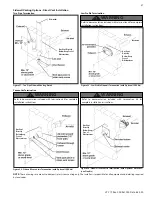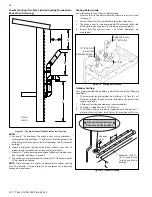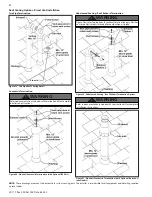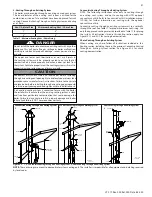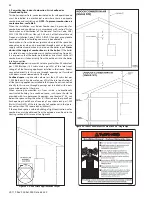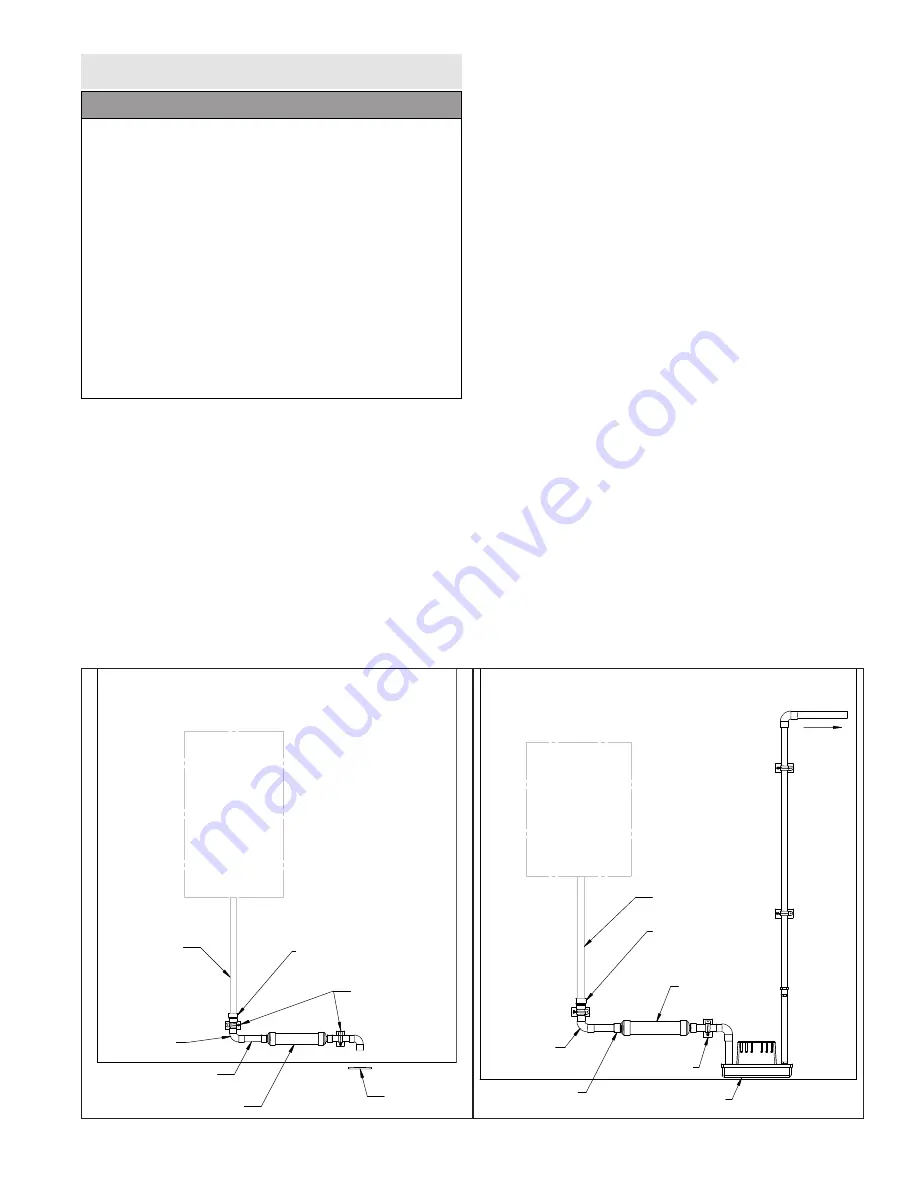
LP-719 Rev. 000 Rel. 000 Date 6.25.20
43
Part 6 - Installing the Condensate Drain
NOTES:
1. Due to its efficient design, the boiler produces condensate (water)
as a normal by-product. This condensate is acidic, with a pH level
between 2 and 4.5. This condensate must be drained away from the
boiler and disposed in accordance with all local regulations.
2. The condensate line should be as short as possible and must be
pitched at least ¼” per foot to properly drain. If this cannot be done,
increase the condensate line to a minimum of 1” ID and place a tee in
the line to properly reduce vacuum lock in the drain line. Tees should
be placed after the condensate neutralizer (if used).
3. Use corrosion-resistant materials to drain condensate. Use the
included flexible plastic hose and flexible tube, PVC, or CPVC pipe.
PVC or CPVC pipe must comply with ASTM D1785, F441, or D2665.
Cement must comply with ASTM D2564 for PVC pipe or F493 for
CPVC pipe. For Canadian applications, use CSA or ULC certified
flexible tube, PVC or CPVC pipe, fittings, and cement.
This condensing high efficiency boiler has a condensate removal
system. Condensate is water vapor derived from combustion
products, similar to that produced by an automobile when it is
initially started. It is very important that the condensate line is
sloped down away from the boiler and to a suitable drain.
The condensate line must remain unobstructed. If allowed to
freeze in the line or obstructed in any other manner, condensate
can exit from the boiler tee, resulting in potential water damage
to property.
When installing a condensate pump, select one approved for use
with condensing boilers and furnaces. The condensate pump
should have an overflow switch to prevent property damage from
spillage.
Condensate from the boiler will be slightly acidic (pH from 3.2 to
4.5). Check with your local gas company to determine if combustion
condensate disposal is permitted in your area. Install a neutralizing
filter if required by local codes.
CAUTION
4. If using flexible tube, place an overflow tee in the tube line to
prevent condensate backing up into the boiler if the tube should
kink. Ensure the overflow tee is positioned near a drain or in a
location that will not damage the surrounding area.
5. Do not reduce the size of the condensate line. The line must at
minimum equal the diameter of the line included with the appliance.
6. A frozen condensate line could result in a blocked vent condition.
It is very important to protect the condensate line from freezing
temperatures or any type of blockage. In installations that may
encounter sustained freezing conditions, the use of heat tape is
recommended to avoid freezing of the condensate line. Longer
condensate runs are more prone to freezing.
7. Support of the condensate line may be necessary to avoid
blockage of the condensate flow.
8. Local building codes may require an in-line neutralizer to be
installed (not included) to treat the condensate. See Figure 45.
If required by local authorities, a condensate filter of lime crystals,
marble, or phosphate chips will neutralize slightly acidic condensate
(p/n 7450P-212 available from HTP). Follow all the installation
instructions included with the neutralizer. If a neutralizer is installed,
periodic replacement of the limestone (or neutralizing agent) will be
required. The rate of depletion of the limestone varies with usage
of the boiler. During the first year of boiler operation, check the
neutralizer every few months for depletion.
9. Route the drain line to a nearby floor drain, laundry tub, or
condensate pump. If the boiler condensate outlet is lower than the
drain, you must use a condensate removal pump (kit p/n 554200
available from HTP).
NOTE:
If a nearby laundry tub is used as a disposal for waste water
from the washing machine, draining the condensate into this tub
allows the soapy water discharge to neutralize the acidic condensate.
10. An error will appear on the boiler display if condensate line is
blocked. The boiler will not operate with a blocked condensate
line. It is extremely important to have this condition repaired by a
qualified service technician.
11. Damages due to frozen or blocked condensate lines or leaks ARE
NOT covered by warranty.
NOTE:
To clean out condensate trap, see Maintenance section.
Figure 45 - Condensate Piping Suggestions
REMOVAL TO OUTSIDE SOURCE)
NEUTRALIZER
1" x 3/4" PVC PIPE
OF 1/4" PER FOOT
CONNECTIONS
HORIZONTAL LINES MUST
RECOMMENDED:
TO OUTSIDE
CONDENSATE PIPING WITH PUMP
RECOMMENDED:
EXAMPLE: LOOSE FITING
PIPING SUPPORTS
RECOMMENDED:
BE INSTALLED WITH A PITCH
554200 LITTLE GIANT
CONDENSATE PUMP
OR DRAIN
CONDENSATE
REDUCER - SWEAT
BREAK AND OVERFLOW
(SUGGESTED SETUP FOR CONDENSATE
THROUGHOUT
RECOMMENDED:
CONNECTION FOR VACUUM
RECOMMENDED:
3/4" PVC PIPE SWEAT
PROVIDED FLEXIBLE
CONDENSATE HOSE
06/24/20
LP-723-B
BOILER
CONDENSATE REMOVAL
TO FLOOR DRAIN)
CONDENSATE PIPING
(SUGGESTED SETUP FOR
LP-723-A
06/24/20
BOILER
EXISTING DRAIN
RECOMMENDED
CONDENSATE NEUTRALIZER
BE INSTALLED WITH A PITCH
RECOMMENDED
HORIZONTAL LINES RECOMMENDED
HORIZONTAL
PIPING VERTICAL OR
PIPE REDUCER - SWEAT
3/4" PVC PIPE
OF 1/4" PER FOOT
LOOSE FITTING 1" X 3/4" PVC
PIPE HANGERS RECOMMENDED
BE USED TO SUPPORT
CONNECTION FOR VACUUM
BREAK AND OVERFLOW EXAMPLE:
PROVIDED FLEXIBLE
CONDENSATE HOSE









